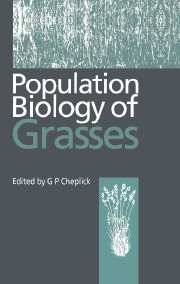Book contents
- Frontmatter
- Contents
- Contributors
- Preface
- Darwin revisited: approaches to the ecological study of grasses
- Part one Population variation and life history patterns
- 1 Allozyme diversity in the grasses
- 2 Ecology of seed dormancy and germination in grasses
- 3 Seed dispersal and seedling establishment in grass populations
- 4 Clonal biology of caespitose grasses
- 5 Ecological aspects of sex expression in grasses
- 6 Interspecific variation in plasticity of grasses in response to nitrogen supply
- 7 Population biology of intraspecific polyploidy in grasses
- Part two Ecological interactions
- Part three Population biology of specific groups
- Index
1 - Allozyme diversity in the grasses
Published online by Cambridge University Press: 14 September 2009
- Frontmatter
- Contents
- Contributors
- Preface
- Darwin revisited: approaches to the ecological study of grasses
- Part one Population variation and life history patterns
- 1 Allozyme diversity in the grasses
- 2 Ecology of seed dormancy and germination in grasses
- 3 Seed dispersal and seedling establishment in grass populations
- 4 Clonal biology of caespitose grasses
- 5 Ecological aspects of sex expression in grasses
- 6 Interspecific variation in plasticity of grasses in response to nitrogen supply
- 7 Population biology of intraspecific polyploidy in grasses
- Part two Ecological interactions
- Part three Population biology of specific groups
- Index
Summary
Since Lewontin & Hubby (1966) and Harris (1966) independently discovered allozyme polymorphisms within populations of Drosophila and humans, allozymes have provided the most widely used descriptors of genetic diversity in natural plant and animal populations. Their usefulness can be ascribed to several features, including codominant expression, apparent neutrality, and ease and cost of detection. Today allozymes are utilized in studies of plant populations to determine breeding systems, describe mating systems, determine paternity, estimate gene flow via seed and pollen, examine clonal structure, and determine systematic relationships (Soltis & Soltis, 1989). In conservation biology and crop science, the description of genetic structure provides sampling guidelines for the ex situ and in situ preservation of genetic diversity (e.g. Marshall & Brown, 1975; Brown & Briggs, 1991; Godt, Hamrick & Bratton, 1995; Swenson et al., 1995; Godt & Hamrick, 1996). Furthermore, allozymes have been utilized to study the evolution of crop species and to identify cultivars (Doebley, 1989; Torres, 1989).
Although allozyme diversity does not necessarily reflect variation in quantitative traits, it provides a handy yardstick for comparisons of diversity within populations and across species. Over 1000 published studies report allozyme variation in seed plants. These represent a wide crosssection of the plant world, although commercially valuable species (i.e. trees and crops) and temperate species have received the most attention. As the number of allozyme studies has grown, several reviewers have described patterns in allozyme diversity and its distribution (Gottlieb, 1977; Brown, 1979; Hamrick, Linhart & Mitton, 1979; Crawford, 1983; Hamrick & Godt, 1989).
- Type
- Chapter
- Information
- Population Biology of Grasses , pp. 11 - 29Publisher: Cambridge University PressPrint publication year: 1998
- 36
- Cited by



